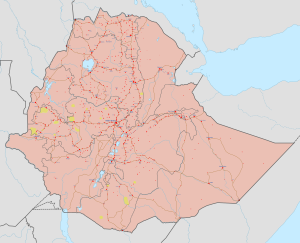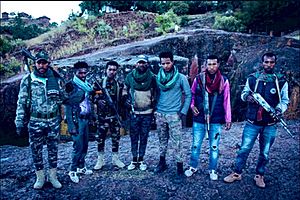War in Amhara facts for kids
Quick facts for kids War in Amhara |
|||||||
|---|---|---|---|---|---|---|---|
| Part of Ethiopian civil conflict (2018–present) | |||||||
 Territorial control as of August 2023 |
|||||||
|
|||||||
| Belligerents | |||||||
| Commanders and leaders | |||||||
| Unknown commanders | |||||||
The War in Amhara is a conflict happening in the Amhara Region of Ethiopia. It started in April 2023. This fight is between local forces, including a group called Fano, and the Ethiopian government.
It began when the Ethiopian military tried to take weapons from local groups like the Amhara Special Forces. This led to resistance and protests in cities like Gondar, Kobo, Sekota, and Weldiya starting on April 9.
On April 27, Girma Yeshitila, a leader of Amhara's Prosperity Party, was killed in Menz. The Ethiopian government believed a part of the Fano group was involved. On April 30, Ethiopian security forces arrested 47 people they thought were connected to this event.
On May 4, 2023, the Ethiopian Human Rights Commission (EHRC) reported that there were military situations in four towns. These towns were in the North Gondar, North Wollo, and North Shewa areas.
Why the Conflict Started
Local Amhara forces played a big part in the Tigray War. They fought alongside the Ethiopian National Defense Force against the TPLF. During the Tigray War, there were also clashes in the Oromia Special Zone of the Amhara Region. This was between the Oromo Liberation Army (OLA) and Amhara Special Forces.
Witnesses said that the OLA, along with other Oromo fighters, took control of Ataye town on March 20, 2021. At that time, the OLA was working with the Tigrayan rebels.

A peace agreement was signed in November 2022 between the Tigrayan and Ethiopian governments. This agreement led to more activity from the OLA insurgency. The OLA was involved in attacks on Amharas in the Oromia region. In May 2022, the government arrested 4,000 people in Amhara. This was to weaken the Fano group, who had become critical of the government.
Fano's goals in 2020 included wanting certain areas like Benishangul-Gumuz Region's Metekel Zone, and parts of Tigray and Oromia to be part of the Amhara Region. The peace agreement meant that the Ethiopian leaders were no longer interested in helping Fano achieve these land goals. This, combined with the OLA's actions, quickly made the relationship between Fano and the government much worse.
Conflict Begins and Emergency Declared
In early April 2023, government forces entered the Amhara region to disarm local and unofficial military groups. Many local people moved to safer areas. Fighters who resisted joined protests with police forces.
On April 9, large protests started in cities like Gondar, Kobo, Seqota, and Weldiya. People blocked roads and burned tires to stop the Ethiopian Army. The government also started to limit news from opposition groups in the region.
On May 4, the Ethiopian Human Rights Commission (EHRC) reported military actions in several towns. The Amhara regional government blamed the eastern part of the Fano group for the killing of Girma Yeshitila on April 27. After this, Ethiopian security forces arrested 47 people. They believed these people were involved in the killing and planning to overthrow the government. The public news channel, EBC, said that the arrested people had various weapons and communication tools.
From August 1 to 2, Fano and the ENDF started fighting again in Debre Tabor. The fighting in Kobo was very strong on August 1 but calmed down the next day. Some reports said that the Fano group took control of Lalibela Airport. An ENDF spokesperson warned that the military would act if Fano continued to cause trouble. Spain's embassy in Ethiopia advised Spanish tourists not to leave the city.
On August 4, the Ethiopian government declared a state of emergency. This put the Amhara region under military control. Rules included curfews, limits on travel, internet shutdowns, and bans on public gatherings. The ENDF military quickly moved in and took back major towns like Gondar, Lalibela, and Bahir Dar by August 8.
Impact on People
The Ethiopian Human Rights Commission has reported that many human rights violations have happened in the Amhara Region. The EHRC stated that the Ethiopian Air Force used shelling and airstrikes in places like Debre Birhan, Finote Selam, and Bure. These attacks caused harm to civilians and damaged homes and public areas.
Reuters reported that an airstrike in the center of Finote Selam killed 26 civilians and injured 55 people. People of Amhara background living in the capital city, Addis Ababa, were also reportedly arrested by security forces.

